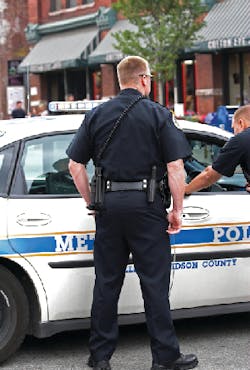Declining budgets are forcing sheriffs and police departments to adopt technology as a “force multiplier” in their battle against crime. Affordable technology, not more officers, is the answer; in fact, over the past three decades video has become law enforcement’s single most important technology tool for fighting crime and millions of cameras have been installed to improve community safety.
The affordable video revolution is finally reaching the alarm industry — and video verification by the central station is a paradigm shift in commercial alarm systems for business customers large and small. A video verified alarm is reviewed immediately by the central station operator and this “eye witness dispatch” receives priority response from law enforcement.
In Grand Prairie, Texas, for example, this means that officers arrive at the premises in less than two minutes instead of fifteen for a typical alarm. Faster response means more arrests and fewer losses. Monitored video alarms also mean fewer false alarm fines that are becoming increasingly expensive to the bottom line.
Impact on the Retail Market
Monitored video has been around for decades and nowhere more so than in the large national retailers who have already deployed thousands of cameras to monitor store operations. A leading drugstore chain, for example, has integrated its alarm systems with surveillance cameras in more than 4,000 individual stores to deliver faster police response in the event of a burglary. The nationwide pharmacy retail chain monitors its own security systems from an internal central station that combines the alarms/cameras into a single system for operators.
For retailers unwilling or unable to create their own central station, specialized video monitoring partners have made video verification possible; however, until recently, video verification has simply been too expensive to be a mainstream alarm function — especially for small commercial applications.
Specialty video monitoring companies that have provided the service generally charged a premium price beyond what most small businesses could afford —that is changing; in fact, it already has.
Declining hardware costs and important evolutions in central station automation have altered the security landscape. Inexpensive video cameras are now everywhere — in smartphones, laptops, iPods, car bumpers and now they are being included in wireless alarm sensors. While CCTV cameras have become less expensive, monitoring solutions at the central station have also improved to the point that monitoring a standard video alarm system no longer requires a dedicated team of operators trained in all the details of DVRs and pan/tilt/zoom. The new video alarm solutions are cost effective and able to scale because they are monitored by the normal central station operators and have become a “normal alarm.”
Inexpensive hardware and cost-effective monitoring options mean that video verified alarms are moving mainstream — affordable to the typical small business. The hardware/installation costs of a video alarm are now nearly comparable with a traditional system as the various components are now wireless and battery-powered for easy installation and no Ethernet or power cords.
National companies like Stanley, Protection 1 and Diebold have positioned verified alarms as a standard commercial solution instead of an expensive niche offering. It is more than affordability, the real driving force behind commercial customers embracing video verified alarms is priority police response and greater security — they want the best response possible and verified alarm deliver police.
In addition to greater security, new “smartphone interactivity” features of these same monitored systems also provide incremental value to the business owner or store manager. While a video sensor will send a video clip of an alarm event to the central station for immediate review/dispatch, these same cameras are also available for the business owner to provide a visual status at their smartphone. In other words, the monitored video alarm delivers priority response but the owner can still access these cameras from their smartphone for remote viewing of their business. The cameras can provide quick answers to questions like, “Did the staff open up on time? Is the door to the cash room door closed? Have they restocked the shelves?”
Retail Security Future-Proofing
While priority response, more arrests and lower losses are important, so is uniformity. Security directors are installing audio/video-verified alarms to future-proof their stores to be compatible with evolving response policies. The security directors at the national retail chains want a consistent alarm platform that will not become obsolete because of a policy decision of a local police chief or sheriff.
A recent study from COPS (Community-Oriented Policing) describes the trend: “The nation’s law enforcement agencies are confronting severe budget cuts and unmanageable layoffs, and they are fundamentally changing how they keep the public safe….The delivery of law enforcement services will fundamentally change as a result of today’s economic climate.”
Increasingly, jurisdictions that choose to limit alarm response have done so quickly by a simple change in policy. For example, Detroit provided just 60 days notice before moving to” verified only” response, while Akron, Ohio, provided 90 day notice. In contrast, every U.S. jurisdiction responds to video-verified alarms. Instead of attempting to predict how declining budgets will impact specific jurisdictions, national accounts are installing verified alarms preemptively so they don’t have to worry about evolving alarm response policies impacting store security. National chains need a uniform alarm platform that delivers police response no matter where it is installed, both today and tomorrow.
Also, what seem like subtle nuances in response policies have significant impact on store security. For example, alarm response is actually more complicated than either response or non-response. As the political battle over false alarms heated up, many jurisdictions adopted a “broadcast-and-file” approach, meaning that they made alarm response voluntary — the 911 center broadcasts the alarm over the radio and any officer in the area is welcome to respond as they are able. Video and audio verified alarms still receive mandated response even in broadcast-and-file jurisdictions.
Most of Colorado and many large counties and communities have implemented broadcast-and-file policies as policy option to limit alarm response while minimizing political backlash or outcry from the alarm industry or property owners. Alarm response is “possible” but not “certain,” and the threat of alarm response is still a valuable deterrent. The bottom line, however is that broadcast-and-file is inconsistent and police response can be assured with monitored video alarms.
Editor’s Note: Read how video verification can substantially increase your RMR on page 62 of this issue, available at www.securityinfowatch.com/11472918.
Steve Walker is VP of Customer Service for Stanley Security and is the VP of the Partnership for Priority Video Alarm Response (PPVAR) — a public/private partnership that brings together law enforcement and the alarm industry to develop new audio/video verified alarm standards to maximize the value of verified alarms to combat property crime. For more information visit www.ppvar.org.





